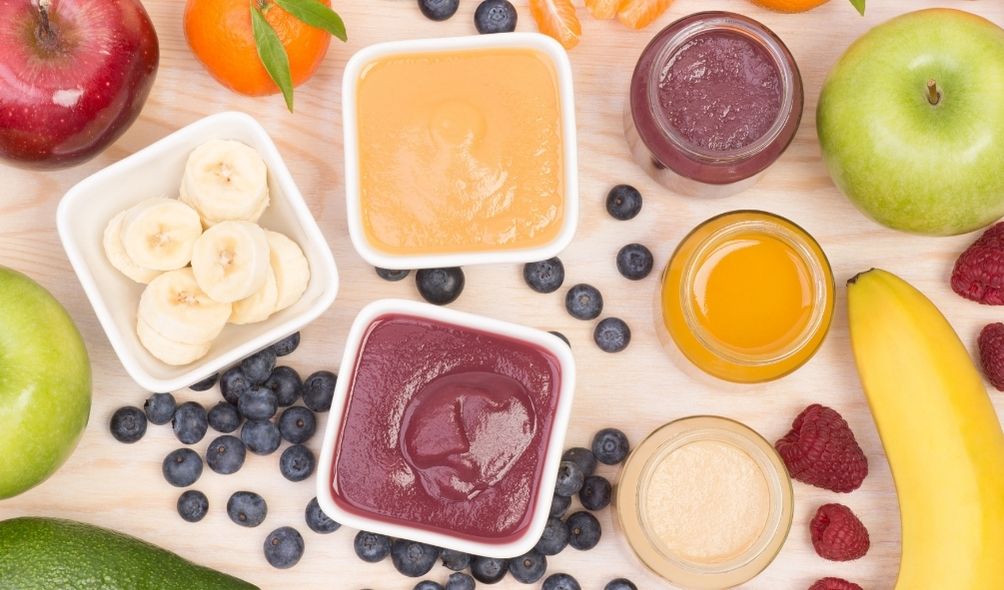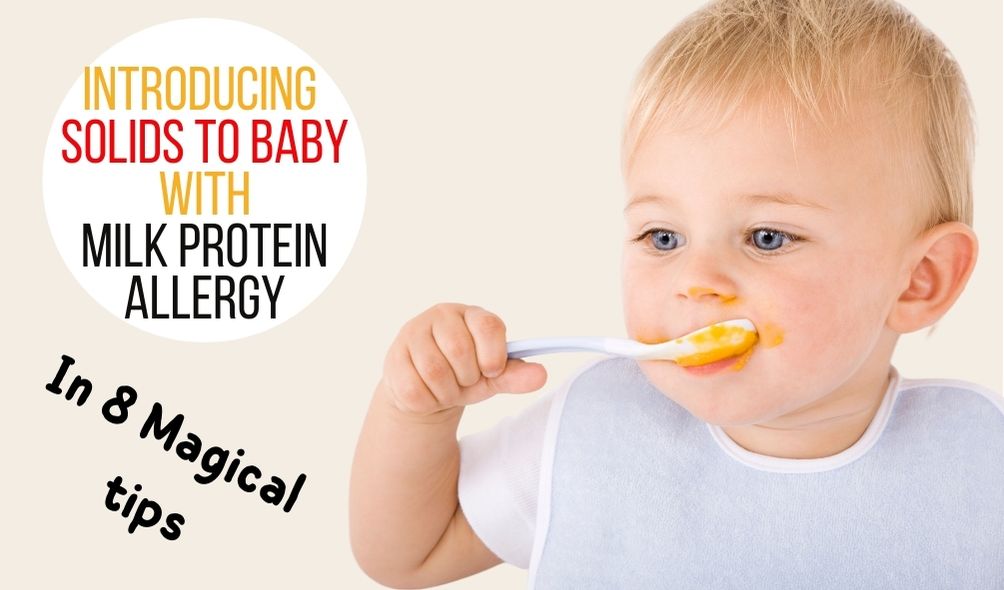Introducing solids to baby with milk protein allergy can be challenging somehow. So, how to do it the right way with the least stress? Let’s see.
Milk allergy occurs when the immune system responds abnormally to one of the proteins in milk, and it causes symptoms as an allergic reaction.
If your child is allergic to milk and dairy products then, you will have to keep it away from him.
In fact, milk contains two types of protein, casein and whey, and the solid part of the milk is known as casein, which includes approximately 80% of the milk protein, while the whey, which is the liquid part of the milk, contains the remaining 20% of the milk protein.
However, other food products such as chewing gum, some bodybuilding drinks, meats, energy drinks, and tuna contain casein.
The study shows that 65% of the total population worldwide have a milk allergy during their childhood. But then they outgrow it before they reach the age of 16. As an allergic reaction usually begins when our immune system believes that the proteins in milk are some invader It reacts with harmful chemicals by releasing a chemical called histamine.
The newspaper added that other foods that may cause such reactions are eggs, peanuts, fish, soybeans and shellfish.
Check our latest posts:
- Can You Chew Sugar-Free Gum While Intermittent Fasting?
- The Coffee Loophole for Weight Loss: Why It Is The Next Fad Diet?
- Optavia Ruined My Life: The Dark Side Of Optavia Diet
- Metabolic Confusion Diet Plan for Endomorph: 30 Days Free PDF
- AIP Reintroduction Phase; How to Start It The Right Way
Milk allergy symptoms
Milk allergy varies from person to person. In some people, symptoms last for a few minutes, while in other cases, it may cause a problem for hours or days. Common symptoms of milk allergy are:
Throat wheezing, tightness, itching around the mouth, swelling of the lips, vomiting and shortness of breath, coughing, runny nose, excessive tears, skin rash, blood in the stool. As there are some proteins in milk, which act as foreign substances for the immune system.
Also, milk allergy is a response to the body’s immune system, as these proteins are present in milk.
So, allergy symptoms occur immediately or later, when the immune system malfunctions.
Naturally, your body recognizes some proteins in milk as foreign and harmful to the body.
As a result, to prevent the damage when the person comes in contact with the milk protein, the antibodies your immune system releases recognize it and produce a group of chemicals such as histamine.
These chemicals cause symptoms such as sneezing, itching and a runny nose. According to medical experts, a child with a milk allergy may be allergic to one or all of the proteins in milk. If these proteins are present in some processed foods, they can also cause allergic reactions in the person.
Milk allergy risk factors
– family history
If there is a history of milk allergy in your family or your parents are allergic to milk, the chances of infection are higher than children too, the same may be affected.
Other allergies
If a person has another type of allergies, such as an allergy to soy and almonds. There is an increased chance of being affected by milk.
– atopic dermatitis
If a person has red, itchy skin called atopic dermatitis, they are likely to have a food allergy.
– Age
Babies are more likely to have a milk allergy, but with age, the digestive system matures, so children with milk allergies are less likely to react to it.
Complications of a milk allergy include:
Eczema, allergic asthma, sensitivity to other types of allergens, hay fever, growth and development problems in children, and death due to anaphylaxis.
Diagnosis of milk allergy
Medical history: The doctor will do a physical exam and ask about the details of the food you eat each day.
Blood test: A blood test will determine the amount of antibodies in your blood. A skin test, a skin test is done to see if you are actually allergic to milk protein or not. This is done by exposing the skin to a small amount of milk protein, and if the above tests fail The doctor will suspect that there is another type of allergy instead of a milk allergy. For a milk allergy, avoid milk and all products that contain milk.
People with a milk allergy should properly check the ingredients described in the product and then consume it, usually For a severe allergic reaction (anaphylactic shock), doctors advise a patient with a milk allergy to keep an epinephrine auto-injector. Good for people with allergies.

Introducing solids to baby with milk protein allergy
1- Check the ingredients section of processed foods for any signs of milk on the menu.
2- Always carry an epinephrine injection, keep a diary to write down the foods your child ate in the day, and any side effects you notice after eating.
3- Do not miss medications to maintain symptoms.
4- Know the sources of milk that should avoid them: yogurt, buttermilk, low-fat milk, whole milk, cheese, or cheese-based products.
5- Give your baby one type of food at a time especially the foods you doubt it may contain milk traces. After that, wait few days to make sure your baby isn’t allergic to that food.
6- It is difficult for people to identify milk in some products, as the ingredients do not contain the word “milk”, but there are other names in its form.
The easiest ways to identify milk are through the following names:
- Casein.
- Coriander rennet.
- Hydrolyzate.
- Other names that contain On the word casein in it, such as lactalbumin and lactoglobulin, lactose, lactulose, or words beginning with “lact”, whey or butter, or cheese flavour.
7- Start feeding your child with natural foods like vegetables and fruits that there is no doubt they contain 0.001% milk.
8- You may think cereals won’t be the right option for your child as you must mix them with milk. Fortunately, you are wrong, you may try rice cereals with milk alternatives like oat and almonds milk. Also, you may use milk formulas made for babies with milk allergy like Nutramigen.
